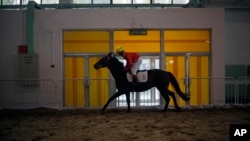Across Asia, the increase in sales of luxury goods has been sparked, in part, by the rise of China's middle class. Among the unusual luxuries enjoyed by some wealthy Chinese is the ownership of horses. The lifestyle associated with horses has become a new status symbol among a small but growing group of mainland Chinese.
Mao Zedong, the founding father of the People's Republic of China, banned horse racing in 1949 as a shameful capitalist pursuit.
More than 60 years later, racetracks, polo fields and jockey clubs are opening for business in Chinese cities. There is a rapid rise in the number of horses imported from abroad.
Maiken Jaeschke, a manager at Equestrian Globe, a German company that imports horses into China, builds equestrian facilities and sells riding gear and equipment, says the business is booming.
“China has seen a huge increase in the equestrian world and the equestrian market in general, and the interest in the horse world and horse sports in general over the last ten years or five years, intensively, there has been a lot of growth in competition where people can participate and show their skills. There has been a big increase in horse sales, especially imported horses,” says Jaeschke.
China now has 300 equestrian clubs and 25 race tracks. Developers of a $2 billion Tianjin Equine Culture City, in Tianjin, China, promise 4000 stables, a state-of-the-art horse clinic, 150 trainer offices, training tracks, racecourse and clubhouse, and international equestrian college. The facility is still under construction.
Shen Ge, who lives in Beijing, is a Chinese buyer. His 15-year-old daughter, Shen Qing, is one of the youngest competitive riders in China and competes internationally in show jumping.
“During the past 10 years we bought about 10 different horses. In the beginning it was all local, China horses, not very good. We sell and buy, and we were cheated and gained that experience, but last year we bought some horses from Holland and Belgium and we still have a horse there and two in China right now,” says Shen Ge.
Ups and downs
Shen Ge says although there is a genuine passion for equestrian sports in China, bad dealings between European horse sellers and Chinese buyers have damaged trust in the international market.
Shen cites examples of Chinese buyers attempting to bargain for horses, canceling deals and contracts at the last minute and even disappearing after a horse is en route to China and the seller has already spent thousands of dollars on the shipping procedures.
Such stories have not scared off American David Snodgrass, who brought the first American quarter horses to China. He says the market for quarter horses has increased in the last couple of years.
“We work in saddle breds and standard breds and with those breeds we’ve seen steady growth over the last three or four years. But the general theme is, our belief is that the market isn’t going to grow unless we get more training and assistance for clubs and more competitions. So that has been our focus for the last two years. We are putting on more horse shows, trying to show people that it’s easy to get involved, and that it is fun and not all about the money,” says Snodgrass.
Horse sellers say the market will only grow as interest in the sport deepens.
Shen Ge has built his career in business marketing, but says his passion for horses keeps him in the stables during most of his free time. He has passed this hobby onto his daughter, Shen Qing, and says she represents the future of the Chinese equestrian market. This month, Shen Qing will head to Italy for yet another international jumping competition.







